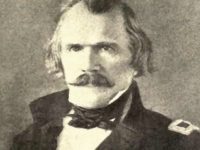Albert S. Johnston was one of the most able officers in the US Army until he joined the Southern States at the beginning of the American Civil War. There he put his tactics to the Northern States heavy losses, had it not fallen during the war, this could have ended differently.
Origin and teenage years:
Albert Sidney Johnston was born on February 2, 1803, to Washington, Mason County, Kentucky, but spent most of his time in Texas, which he described as his home.
He began his first training at Transylvania University in Lexington, where also the later President of the Confederation Jefferson Davis completed his education.
Beginning of military service:
Like many other officers of the US Army and the later Confederate Army, Johnston began his military training at the Military Academy in West Point, New York. In 1826 he completed his education there and was transferred as brevet lieutenant to the 2nd US Infantry Regiment.
During the Black Hawk War of 1832 with the Indians living east of the Mississippi River, he served as Chief of Staff of General Henry Atkinsons.
In 1834 Johnston ended his military service to take care of his 1829 married wife, who contracted tuberculosis. After her death, he farmed a farm in Texas.
Johnston's service during the Texas War of Independence:
During the War of Independence between Texas and Mexico from October 2, 1835 to April 21, 1836 Johnston joined in 1836 as a private in the Texan militia, but was soon promoted to Major. After the war, he was promoted to colonel in August and received the post of Adjutant General of the Army. Already on January 31, 1837 was the next promotion to brigadier general and the post as commander in chief of the Texas Army.
In 1838, Johnston was appointed Minister of War by the second President of the Republic of Texas, Mirabeau B. Lamar. However, he resigned from office in February 1840, remarried, and then worked with his new wife on a plantation in Brazoria County.
The Mexican-American War:
As on April 25, 1846, the Mexican-American War broke out, Johnston reported again to the military and got as a colonel in command of the 1st Texas Rifles Regiment. Johnston fought, among others, in the battles of Monterrey and Buena Vista.
After the war ended on 2 February 1848 Johnston returned to his plantation, but already in 1849 he was promoted by the US President Zachary Taylor to major and used as a paymaster in the US Army. In 1855 he was given command of the 2nd US Cavalry Regiment. In late 1860 he became commander of the Pacific Defense Division.
The American Civil War:
As some southern states dissolved from the Union of the United States of America and founded their own state with the Confederacy, Johnston left after the exit Texas to the north and went to the new Confederate capital Richmond in Virginia. After Jefferson Davis took office as Confederate President, this promoted his friend Johnston to the general and gave him the command of the troops that should secure the western areas.
Unlike the eastern theater of war, which concentrated on the Virginia area, Johnston had to secure a much larger area with fewer troops. This circumstance meant that he lost in early 1862 Tennessee in the northern states.
On April 6, 1862 Johnston tried by a daring attack on the Northern Army under the leadership of Major General Ulysses S. Grant to recapture the lost areas. Unlike other officers, Johnston has always been at the forefront of battle and personally led his soldiers into battle. During the Battle of Shiloh, this behavior was doomed to him, as Johnston was hit by a bullet and due to this slowly bleeding to death.
The loss of Johnston was a moral blow for the Confederate Army. Only with General Robert E. Lee could a suitable commander-in-chief for the Confederate armed forces be found again.
Albert Sidney Johnston was buried at the Texas State Cemetery in Austin.
This post is also available in:
 Deutsch (German)
Deutsch (German)  Français (French)
Français (French)  Italiano (Italian)
Italiano (Italian)  简体中文 (Chinese (Simplified))
简体中文 (Chinese (Simplified))  Русский (Russian)
Русский (Russian)  Español (Spanish)
Español (Spanish)  العربية (Arabic)
العربية (Arabic)












